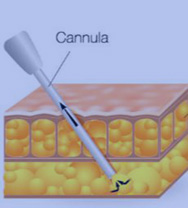How to avoid skin redundancy during high-definition liposuction
Skin redundancy is a critical factor when considering high-definition body contouring. This is because high-definition liposuction predicates maximum removal of fat. When complete fat removal is achieved, the overlying skin will intuitively become redundant.
The analogy I often use is like that of a piece of fruit or balloon. If you de-pulp the fruit or deflate the balloon, the outer shell will become wrinkly! If your skin appears wrinkled, often referred to as cellulitic in appearance, then this may be considered a botched liposuction procedure.
Several measures are utilized to counter the creation of skin redundancy both during surgery as well as postoperatively. These include:
- Skin retraction created by VASER liposuction
- Delivery of internal Radiofrequency
- Skin excision or tucking procedure.
Factors that Increase Redundancy Risks
Certain patient factors make skin laxity more likely following HD lipo:
- Age over 40 – skin loses collagen and elasticity over time (2)
- Significant fat removal – the more fat taken out, the more skin may sag
- Prior weight fluctuations – repeatedly stretched skin has reduced rebound ability
- Excess skin before surgery – occurs after major weight loss (3)
- Sun damage – impairs collagen leading to loss of skin tone (4)
Smoking and conditions like diabetes also negatively impact skin health and wound healing.
Surgical Techniques to Reduce Skin Laxity
Experienced cosmetic or plastic surgeons use methods before, during, and after HD lipo to combat skin redundancy including:
Preoperative Skin Assessment and Planning

- Analyzing skin tone, thickness, elasticity
- Conservative fat removal goals based on skin quality
- Identifying any areas needing skin tightening
Controlled, Gradual Fat Removal
- Meticulous, gradual suction technique
- Allowing skin time to retract between passes
Fibrous Septum Preservation
- Keeping intact the fibrous partitions between fat pockets provides infrastructure for the skin (5)
Post-Surgical Compression and Skin Retraction Protocols

- Strategic bandaging to keep skin taught
- Endless bounding exercises to encourage skin retraction
Additional Skin Tightening Procedures
- Laser skin resurfacing and ultrasound treatments
- Cutting excisions for very redundant areas if needed
- Radiofrequency treatments to stimulate collagen
Intraoperative Measures to avoid Skin Redundancy
Skin retraction

Skin retraction with VASER liposuction is an intraoperative measure that allows us to avoid skin redundancy. Skin integrity is maintained throughout your entire body by a series of collagen-made cables that traverse from the skin deep to the underlying muscles. These structural cables are surrounded by your fat cells.
In essence, the fat cells act like sponges that prevent the cables from shortening down. When fat is removed during liposuction, these cables, otherwise known as fibro septal networks, contract and allow for skin retraction. What makes VASER liposuction particularly effective in skin retraction is that the superficial soft tissue layers possess a higher density of cables than the deeper layers of the soft tissues.
Since only VASER liposuction is unique in its ability to remove superficial fat, this makes it most effective in its ability to cause skin retraction. When skin retraction becomes possible using 360-degree body contouring, the entire skin of your body will retract up, described as skin redraping.
In summary, skin tightening with VASER liposuction is indicated for minimal skin redundancy.
Radiofrequency Skin Tightening
Skin and soft tissue contraction by applying internal radiofrequency has become a mainstay of high-definition body contouring. This is because more aggressive fat removal which is a mainstay of hi-def lipo will result in more propensity for skin redundancy. Skin redundancy will result in unwanted contour irregularities that are not desirable to cosmetic clients. The advent of radiofrequency by two companies, Apyx Medical and Attiva, have provided unique opportunities to counter skin laxity. Skin laxity is reduced by shrinking collagen molecules exposed to the safe thermal energy created by focally guided radiofrequency.

Skin excision using specialized tucking procedures
Skin tightening utilizing skin excision is the gold standard for eliminating and avoiding skin redundancy during body contouring. Strategically designed skin excisions can tighten the skin over the abdomen, arms, upper back, lower back, buttocks, and medial thighs.
Procedures have been developed to address any of the above areas, including the mini tummy tuck, reverse, brachioplasty, upper body lift, lower body lift, lateral thigh and buttock, and medial thigh tuck. Gauging the amount of skin to be excised is best achieved following a physical examination in which the skin to be removed is distracted to see the optimal degree of skin to be excised.
In general, skin excision is indicated in patients with moderate to severe skin redundancy.

How to avoid skin redundancy during high-definition liposuction
In conclusion, how to avoid skin redundancy during high definition liposuction is necessary to prevent botched body contouring surgery. The degree of skin redundancy will dictate maneuvers required to tighten the skin.

